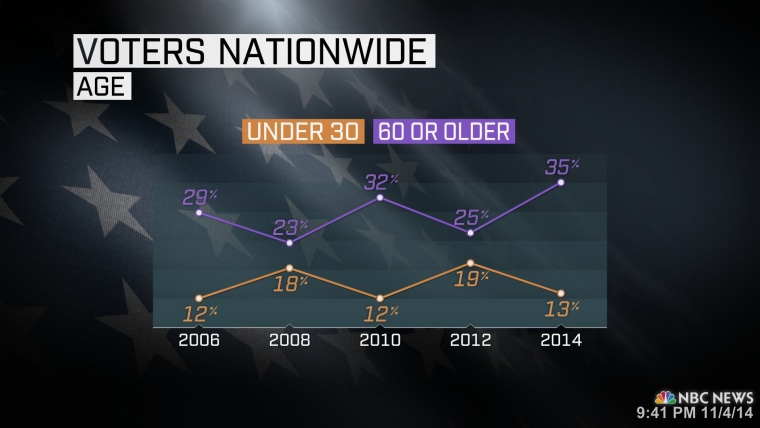The age gap between younger voters and seniors was huge in 2010 and had a lot to do with the Republican wave election. As NBC News'
exit polls found, this was even more pronounced yesterday.
The electorate in midterm elections is much older than in presidential years, with those aged 60 and older generally outnumbering those under 30 by more than 2-to-1 margins. For example, in the 2012 presidential election, 25% of voters were age 60 and older while 19% were under 30 years old. That 6 point difference between the oldest and youngest voters' share of the electorate is similar to the 5 to 9 point gap registered in the prior three presidential elections. In today's midterms, 37% of voters are over the age of 60 but only 12% of are under 30 years old. This 25 point difference is larger than the 16 to 20 point age gap seen in the last three midterms.
It's sort of a good-news-bad-news situation for Democrats. The good news is, the party still enjoys a sizable advantage with younger voters, which will help Dems in the years ahead. The bad news is, they only tend to show up in large numbers every four years, even when the party needs them every two years.
Looking at the data from U.S. House races held nationwide, voters under 30 were one of the Democrats' best constituencies, favoring Dems over Republicans
by 11 points. On the other hand, these voters were also the smallest sliver of the age groups, representing just 13% of this year's electorate.
NBC News' report added:
There was a time when this midterm age gap would have little effect on an election's outcome, but that suddenly changed ten years ago when young voters became decidedly more Democratic than their older counterparts. Throughout the 1990s, the youngest and oldest voters tended to vote the same way. For example, in the 1994 election which resulted in a Republican takeover of the House of Representatives, 48% of voters under 30 voted for the Democratic candidate for Congress and an identical 48% of voter age 60 and older did the same. This trend continued through the 2002, when 49% of young voters and 48% of older voters cast Democratic House ballots.
Again, there's reason for Democrats to see this as an encouraging sign. Younger voters used to be entirely up for grabs, but now we're looking at a generation that not only leans left, but does so far more than any other age group. As a long-term proposition, that's bad news for Republicans, who now rely heavily on the nation's oldest generation.
But this only matters when voters under 30 are prepared to stand up and be counted. This year, they weren't.
Dylan Scott
added, "[This] analysis rang true for those supporting Democrats in key battleground states on Election Day. One source familiar with the Colorado Senate race told TPM on Tuesday that youth turnout there had been 'pathetic.'"
